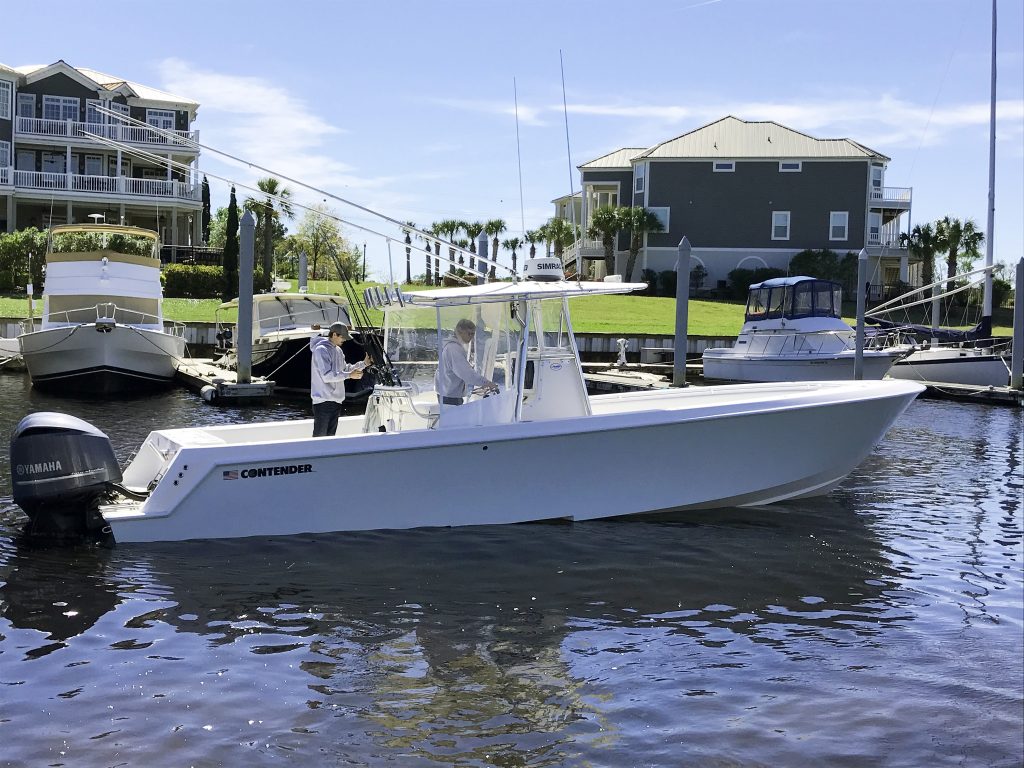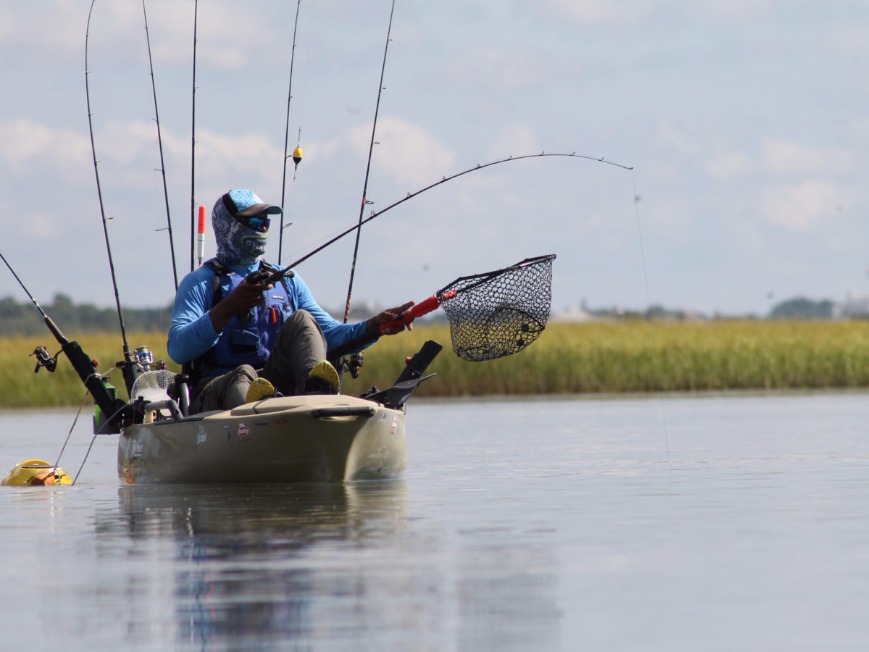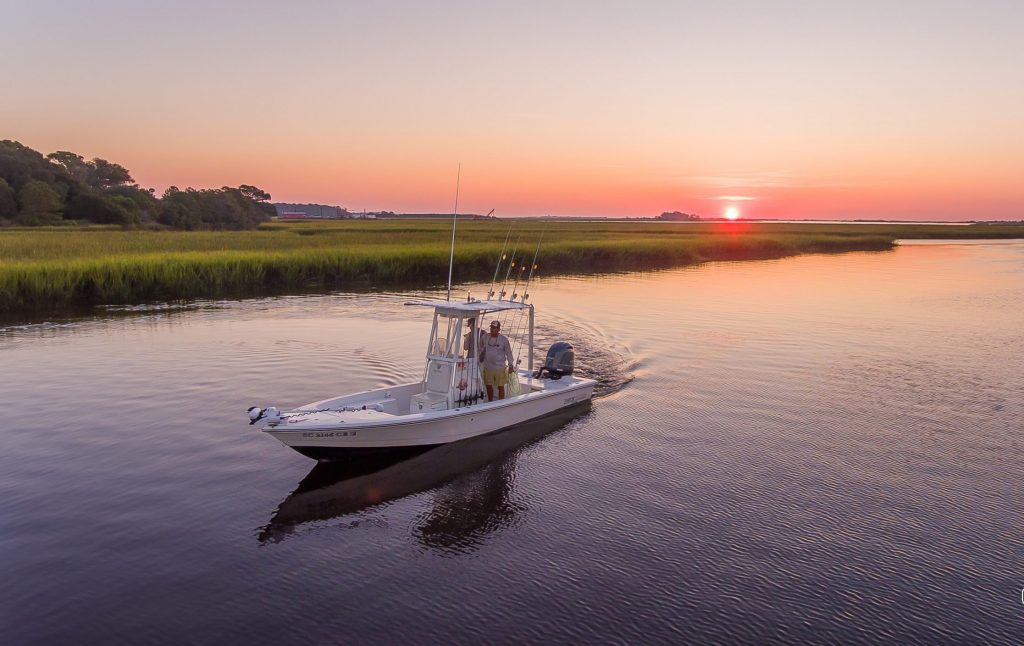Few places in the country can compare to the fishing Mecca that is Myrtle Beach. Located on a stunning 60-mile-long coastal strip on the Atlantic, this place is perfectly suited for an angling adventure. The city might be just over 60 years old, but fishing in Myrtle Beach has already reached legendary heights. What is it that makes this place so special?
Well, for one, being on a strip of land right on the Atlantic certainly helps. The Gulf Stream passes just close enough for the city to experience the best of what the Atlantic has to offer. Things are equally as exciting in inshore waters. Here, the local bays, inlets, and rivers keep the bite going throughout the year.
Fishing in Myrtle Beach has so much to offer, it can make your head spin. With this guide, we’ll make things a bit easier for you. You’ll learn about the area’s top species and where to catch them. You’ll also see what types of fishing Myrtle Beach has to offer, as well as what the current fishing regulations are. Let’s dive in.
Best Fish to Catch in Myrtle Beach
When it comes to fishing in Myrtle Beach, variety is the name of the game. From the grassy flats to the open ocean, the options are seemingly endless. Here are some of the best species you can catch.
Red Drum
A true staple in these parts, Red Drum is an inshore fisher’s favorite. These guys are abundant, and you can catch them pretty much year-round. Reds will eagerly take your bait, but they’ll also put up a good fight at the same time.

You can catch Red Drum in waters as shallow as 5 feet. Look for them around creeks, shallow bays, and oyster bars. Light spinning tackle is all you need for these guys, but you can also try to catch them on the fly.
Tarpon
Some say that catching a Tarpon is the ultimate inshore fishing achievement. Known for its leaping acrobatics, the “Silver King” is one of the hardest-fighting fish out there. Myrtle Beach Tarpon average around 100 pounds, but they can often top the 150-pound mark.
Tarpon fishing heats up around late May when the schools of baitfish draw the Silver King to the shallows. The bite continues all summer, ending in mid-September. They have another shorter run in winter, during January and February.

Tarpon tend to keep away from busy waters, so it’s best to look for them around beaches and estuaries to the south. To find the best spots, an experienced local guide is essential.
Spanish Mackerel

For anglers looking to hook as many fish as possible, Spanish Mackerel are the ideal choice. They like to swim in groups, so find one, and you’ll be in for a treat. They are fantastic light tackle fish, with a penchant for inhaling sardines and shrimp.
Spaniards aren’t huge, but they make up for it with numbers and a lively attitude. They feed near the surface, meaning that you’ll be able to see all the action as it unfolds. If you happen to land a legally-sized Spaniard, you’ll be in for a tasty meal.
Cobia
Fishing for Cobia is on top of many South Carolina anglers’ lists, and it’s easy to see why. Number one, they’re incredibly stubborn fighters. Number two, they are aggressive feeders, taking pretty much anything you throw at them. Last but not least, they make for excellent table fare.

Cobia like to swim around nearshore reefs, looking around underwater structure for bait fish. That means you can catch these guys within just a few miles off the coast. The best time to catch Cobia is late spring through the end of summer.
Mahi Mahi
Offshore fishing in Myrtle Beach is all about big tasty fish. For anglers looking to complete their outing with a memorable seafood dinner, there’s simply nothing better. If this is you, look no further than the colorful Mahi Mahi. Mahi (Dolphin) is not only a beautiful fish, but it’s also fun to catch, and it’s perfect on the grill.

To find Mahi, you’ll need a bigger boat, because you’ll be going at least 15 miles offshore. You can catch them in a variety of ways, but most people like to troll with artificial lures. The best time to catch these boys is from early May through September.
These are just some of the species you can catch in Myrtle Beach. In truth, we could write a whole book on all the fish you can catch here. Before we move on, let’s give out a few honorable mentions. Inshore species: Speckled Trout, Flounder, Pompano, Whiting. Offshore: Wahoo, Blackfin Tuna, Yellowfin Tuna, and Sailfish.
How to Go Fishing in Myrtle Beach
Myrtle Beach is blessed with an array of plentiful waterways. Depending on where you’re wetting your line, you’ll have three types of fishing to choose from. Here’s what you can expect from each one.
Charter Fishing
Hopping on a fishing charter in Myrtle Beach is the best way to get your hands on the fish of your dreams. You’ll not only be able to reach deeper waters and bigger fish, but you’ll also have your guide’s expertise. That means no time wasted guessing where the productive spots are. It also means that you’ll have all the gear you’ll need, as well as all the amenities the boat has to offer.

There are two types of fishing charters you can get: shared and private. A shared fishing charter is a lot more affordable and is the cheapest way to try deep sea fishing. It comes at a price, however. You’ll be sharing the boat with a number of other people, and your guide will have limited time to show you the ropes.
A private charter is a pricier option, but it gives you quality gear and plenty of room on board, as well as your guide’s undivided attention. If you want to experience fishing in Myrtle Beach at its fullest, this is the way to go.
Kayak Fishing
Kayak fishing trips are becoming increasingly popular around Myrtle Beach, and it’s easy to see why. Kayaks allow you to experience South Carolina’s beautiful inshore waterways up close. They also let you slip into some of the best fishing spots completely unnoticed.

Some of the species you can catch from a kayak include Croaker, Red Drum, Flounder, Whiting, and Bluefish. There are plenty of kayak rentals around town, but if you want the complete experience, seek out a kayak fishing guide, and fish the day away!
Shore Fishing
Shore angling is the easiest and cheapest way to experience fishing around Myrtle Beach. It also gives you the flexibility to fish on your own terms. You can choose to escape the crowds and wet a line from one of the many beaches and estuaries.

Alternatively, you can try fishing from one of the local fishing piers. The good thing about pier fishing is that it’s a combination of flexibility and comfort. Most piers are open day and night, so you can fish whenever you want. More importantly, a lot of them offer well-equipped bait and tackle shops, so your gear needs are covered, too.
Recent Myrtle Beach Catches
Fresh fishing reports from anglers
Myrtle Beach Fishing Spots

- Jim Caudle Reef: Covering several acres in just 30 feet of water, the Jim Caudle is the largest artificial reef in South Carolina. It’s made from hundreds of steel and concrete objects, making it a bonafide fish magnet. You can catch Flounder, Cobia, King Mackerel, and Wahoo to name a few. The best part is, that the reef is just over two miles from the coast.
- Pawley’s Island: A barrier island 20 miles south of town, this is the perfect spot for kayak fishing. It’s also great for shore fishing away from the crowds. Catches include Spot, Flounder, Speckled Trout, Weakfish, and Spanish Mackerel.
- Apache Pier: A 1,206′ pier, giving access to the Atlantic. The pier features a tackle shop, a restaurant, restrooms, and a concession store. The pier has its own parking lot. Catches include Spot, Black Drum, and the occasional Spanish Mackerel.
- Pier 14: Great fishing right in the middle of the city. You can catch Spot and Black Drum. There’s a fish cleaning station on the pier, as well as restrooms and a tackle shop. The pier is home to one of the best seafood restaurants in town, with a comfortable lounge area.
- The Gulf Stream: You can’t have a list of places to fish in Myrtle Beach without mentioning the Gulf Stream. While technically not a “spot,” the Gulf Stream is the place to go if you’re serious about offshore fishing. You’ll be going at least 40 miles out, hunting Mahi, Wahoo, Yellowfins, Sailfish, and others.
When to Go Fishing in Myrtle Beach
Fishing in Myrtle Beach is always a good idea. Whenever you hit these waters, a fish will bite. However, if you want to boost your odds of reeling in the exact fish you had in mind or landing a trophy, align your fishing trip with your target’s high season.
Let’s take Redfish as an example to give you an idea of what we’re talking about. You can go Redfish fishing in Myrtle Beach year-round, and the chances are that you’ll score whenever you wet your line. But if you are after Bull Reds, then late fall is your best bet. Trophy Red Drum are getting ready for winter, and the hefty fellas are common, which is usually not the case with spring Reds.
Myrtle Beach Fishing Regulations

Licenses
If you’re fishing from a licensed commerical pier or you’re under the age of 16, you don’t need a license to fish in South Carolina. However, if you’re 16 or older and fishing from a boat, kayak, or the surf, you will need a permit. Prices vary depending on your residency and the type of license you want, and you can get a full list of license fees in our dedicated South Carolina fishing license article.
Bag Limits and Size Requirements
Now let’s cover the fishing regulations for some of the most important species.

Flounder fishing is limited to 5 per person per day and may not exceed 10 per boat per day. The minimum size for Flounder is 16 inches (total length).
For Tarpon, the limit is one per person per day, with a 77-inch fork length requirement. Meanwhile, you can keep two Red Drum, or six per boat, between 15 and 23 inches in total length. Keep in mind that gigging for Redfish is banned from December 1 to February 28.

For Mahi Mahi, the limit is 10 per person per day and 54 per boat per day. The minimum required size is 20 inches fork length. You can also keep 15 Spanish Mackerel, with a minimum requirement fork length of 12 inches, while Kingfish are subject to stricter regulations – three fish per day, with a fork length limit of 24 inches.
Myrtle Beach – An Angler’s Playground
As the tourist hub of the Grand Strand, Myrtle Beach acts like a giant amusement park for the young and old. And just like the action onshore, Myrtle Beach’s fishing scene has something for every fisher. Whether it’s wrestling one inshore fish after another or chasing giants out in the ocean, fishing in Myrtle Beach is an angler’s dream.

So there you have it. Have you ever been fishing in Myrtle Beach? If so, what did you catch? What would you recommend to someone fishing here for the first time? Let us know in the comments below.


